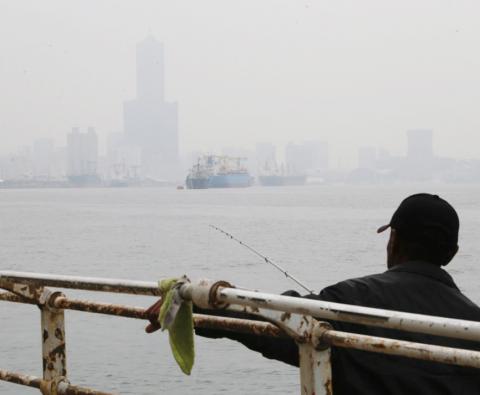Kaohsiung is launching a three-month free public transportation program today to combat the heavy air pollution that often plagues the city at this time of year.
Kaohsiung Mayor Chen Chu (陳菊) at a news conference on Tuesday announced that public transportation will be free for all electronic ticket users.
The program, proposed by the Kaohsiung Environmental Protection Bureau, allows users of electronic tickets, such as iPASS or EasyCard, to take city buses, intercity buses and light-rail trains for free, Chen said.

Photo: CNA
Electronic ticket users can ride the Kaohsiung Mass Rapid Transit (KMRT) system for free on weekdays from 6:30am to 8:30am and from 4:30pm to 6:30pm, she said.
Air pollution in Kaohsiung is particularly severe from December to February, Chen said, adding that the city government has been trying to address the problem by encouraging people to use public transportation.
Bureau Director Tsai Meng-yu (蔡孟裕) said the program is the first of its kind in Taiwan and would cost about NT$200 million (US$6.66 million).
The program could increase ridership on city buses by 1.76 million users, on intercity buses by 70,000 and on the KMRT by 1.6 million, Tsai said, adding that it is projected to reduce carbon dioxide emissions by 16,000 tonnes.
City officials yesterday said that 65 percent of the city’s air pollution comes from overseas, with factories (38 percent), construction sites (24 percent) and vehicles (38 percent) accounting for the remaining 35 percent of pollution that is produced locally.
The bureau said it has managed to control all sources of pollution except vehicles, which is why it was introducing the free public transportation program.
In related news, poor air quality in southern Taiwan is expected to continue into the weekend, the Environmental Protection Administration (EPA) said yesterday, urging sensitive groups to avoid outdoor activities as a precaution.
As of noon yesterday, air quality in the north, particularly in Taoyuan, Hsinchu County and Miaoli County and central Taiwan, had improved significantly from Wednesday, when most of the nation was subject to high levels of PM2.5 — airborne particles measuring 2.5 micrometers or less — the EPA’s Taiwan Air Quality Monitoring Network showed.
The Air Quality Index (AQI) was green (good air quality) or yellow (fair to good) in those areas.
However, the AQI remained orange at six monitoring stations in the south — including Yunlin, Chiayi and Pingtung counties, as well as Tainan and Kaohsiung — meaning that the air quality in those areas remains unhealthy.
A red index was recorded at 12 monitoring stations in those areas, indicating that the poor air quality poses a threat to sensitive groups such as children, seniors and people with heart, respiratory and cardiovascular ailments.
With the red index expected to remain for Kaohsiung and Pingtung until tomorrow, the EPA advised residents in those areas to minimize physical activities if they experience eye irritation, coughing or a sore throat, or to wear a mask when outdoors.
The EPA’s AQI takes into account ozone, PM2.5 and PM10 particulates, carbon monoxide, sulfur dioxide and nitric oxide concentrations in the air.
Additional reporting by Ko Yu-hao

Taiwan is to commence mass production of the Tien Kung (天弓, “Sky Bow”) III, IV and V missiles by the second quarter of this year if the legislature approves the government’s NT$1.25 trillion (US$39.78 billion) special defense budget, an official said yesterday. Commenting on condition of anonymity, a defense official with knowledge of the matter said that the advanced systems are expected to provide crucial capabilities against ballistic and cruise missiles for the proposed “T-Dome,” an advanced, multi-layered air defense network. The Tien Kung III is an air defense missile with a maximum interception altitude of 35km. The Tien Kung IV and V

The disruption of 941 flights in and out of Taiwan due to China’s large-scale military exercises was no accident, but rather the result of a “quasi-blockade” used to simulate creating the air and sea routes needed for an amphibious landing, a military expert said. The disruptions occurred on Tuesday and lasted about 10 hours as China conducted live-fire drills in the Taiwan Strait. The Civil Aviation Administration (CAA) said the exercises affected 857 international flights and 84 domestic flights, affecting more than 100,000 travelers. Su Tzu-yun (蘇紫雲), a research fellow at the government-sponsored Institute for National Defense and Security Research, said the air

Taiwan lacks effective and cost-efficient armaments to intercept rockets, making the planned “T-Dome” interception system necessary, two experts said on Tuesday. The concerns were raised after China’s military fired two waves of rockets during live-fire drills around Taiwan on Tuesday, part of two-day exercises code-named “Justice Mission 2025.” The first wave involved 17 rockets launched at 9am from Pingtan in China’s Fujian Province, according to Lieutenant General Hsieh Jih-sheng (謝日升) of the Office of the Deputy Chief of the General Staff for Intelligence at the Ministry of National Defense. Those rockets landed 70 nautical miles (129.6km) northeast of Keelung without flying over Taiwan,

A strong continental cold air mass is to bring pollutants to Taiwan from tomorrow, the Ministry of Environment said today, as it issued an “orange” air quality alert for most of the country. All of Taiwan except for Hualien and Taitung counties is to be under an “orange” air quality alert tomorrow, indicating air quality that is unhealthy for sensitive groups. In China, areas from Shandong to Shanghai have been enveloped in haze since Saturday, the ministry said in a news release. Yesterday, hourly concentrations of PM2.5 in these areas ranged from 65 to 160 micrograms per cubic meter (mg/m³), and pollutants were